Cutting Edge Retro-Design Saves Big Dollar Down-Time
Linear Systems Australia recently played a major part
in providing one of Australia's leading automobile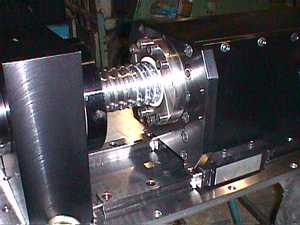 manufacturers with enormous savings in production down-time costs.
manufacturers with enormous savings in production down-time costs.
The auto manufacturer had a production critical ball screw on its Robotic Weld
Line where floor pan, roof and side panels are stitched. The function of the
ballscrew is to lift these primary vehicle assemblies on a shuttle bar as they
are moved through the robot cells. The original ballscrew, which came fitted
to the imported assembly line, had operated without problems for in excess of
3 years. However serious problems developed for the company when an early failure
of a replacement screw was then subsequently followed by the necessity to repeat
that replacement a further 3 times over a 12 month period. Lost production caused
by downtime on the line for these failures was estimated in excess of $1.5M
Fortunately Linear Systems Australia had just run a front page
in Manufacturers Monthly for THOMSON Ballscrews as the fourth replacement screw
was giving evidence of imminent collapse . One of the company engineers noted
the ad ,contacted LSA and provided details of the application and its problems
for assessment and comment.
Drawings highlighted a set up where the screw was supported at one end only
. While a short travel length of around 700mm was required over a screw length
of 1.3 metres, the load being lifted, including bodies and tooling was approximately
20 tonnes. The lift was achieved by connecting the ball nut to a racked con
rod of 100 metres in length. The con rod activated several rack lifters supported
by pneumatic assistance at critical points along the line. The flanged ball
nut was connected to the con rod by a square steel tube which was supported
on a single 65mm Linear guide rail . All in all a 20 tonne lift in 4 seconds
on an 80mm diameter screw with peripheral assistance, for several hundred lifts
a day , was a little different to the normally assessed applications.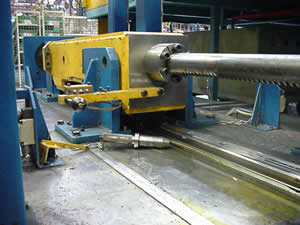
As with all ballscrew and linear guide combinations the necessity for maintaining
close tolerance alignment is critical. Descriptions of the catastrophic failure
mode given verbally by the Auto maker definitely leaned towards a suggestion
of an out of alignment situation . This however was not the answer that the
company was looking for because they had been extremely meticulous to the point
of engaging a laser alignment contactor, in setting up the 4th replacement installation.
LSA considered that if any twist existed within the metal framework upon which
the screw and guide rail were mounted then it would cause misalignment load
hot spots in the body of the ball nut. These load hot spots squeeze the re-circulating
steel balls through the heavier loaded areas between the nut body and the screw,
spitting them out at very much higher than normal acceleration rates. These
higher acceleration rates then create heavier impacting of the balls against
the hollow tube type pick up fingers which these nuts were using. Constant higher
level impacts will cause the pick up fingers to snap off resulting in catastrophic
nut failures. LSA then asked if the company had kept the failed screws for analysis
purposes which they had wisely done , these were forwarded on for inspection.
On receiving the failed nuts the first observations noted that the screws were
in generally good condition along the surface length and that the nuts were
jammed at the point of failure on the screw which supported the theory of pick
up finger breakage . When disassembled the evidence was very clear that all
but one of the 8 fingers in 2 nut bodies supplied had snapped off and the one
that was left intact had a bullet like impregnation in its surface suggesting
extremely heavy ball impacts. The screw surface was badly spalled at these points
where the nuts had jammed because the balls could no longer re-circulate through
the external hollow return tubes. All of this damage supported a misaligned
set up which was accepted by the customer when shown the evidence and LSA was
requested to supply a re-design that would get the company back to acceptable
performance levels from this production line.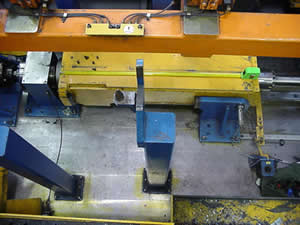
It was obvious that any re-design should be mounted on an independent base which
would guarantee in-built alignment. As hollow tube pick up fingers should be
avoided where very heavy loads can develop it was decided to try and include
a solid steel internal ball changeover mechanism which is a design available
from Thomson IBL ( UK ).
As this was such a critical line for the auto maker they needed full design
drawings before considering any radical changes. LSA utilised the full 3D concept
design capability of IRONCAD to present the company with a visual layout with
detailed internal views as well as drawings which they then accepted as a better
option.
The major design changes centred around building the system
on an independent base plate and then providing non-drive end bearing support
for the ball screw. Mounting of the connecting tube on 2 X 40mm Linear guides
with solid lubricant wipers and using internal nut solid steel ball returns
to avoid breakage. Last but not least changing the con rod connection to a swivel
joint to avoid external load from shaft deflection moving into the assembly.
Having the design approved by the customer, LSA then called on the expertise
which exists within its own customer base to assist with manufacture , assembly
and installation on site for the Auto maker.
The base plate was milled to a precision tolerance uniform thickness and then
machined and drilled by Marand Engineering (Vic). Connector face plates and
sides were drilled and machined by Enterprise Tooling (Vic) and Bellato Engineering
(Vic) handled all assembly and on site installation at the plant which went
very smoothly under Linear Systems Australia supervision. The ballscrew was
built by Thomson IBL (UK) and has performed reliably now for 2 years without
problem.
This is a good example showing how retro engineering can provide cost effective
solutions where a current application is having problems . Presentation of sound
design combined with a skills base which produces quality output is an area
where LSA can see future opportunities to involve its own client base in solution
as well as turnkey projects.
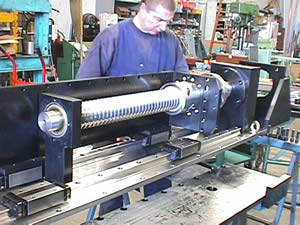
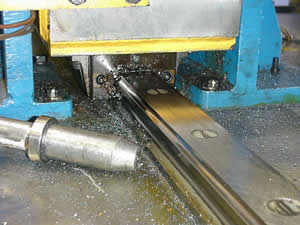
 manufacturers with enormous savings in production down-time costs.
manufacturers with enormous savings in production down-time costs.


